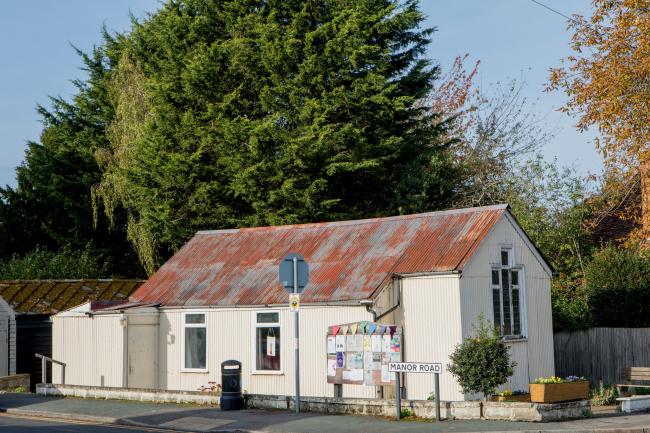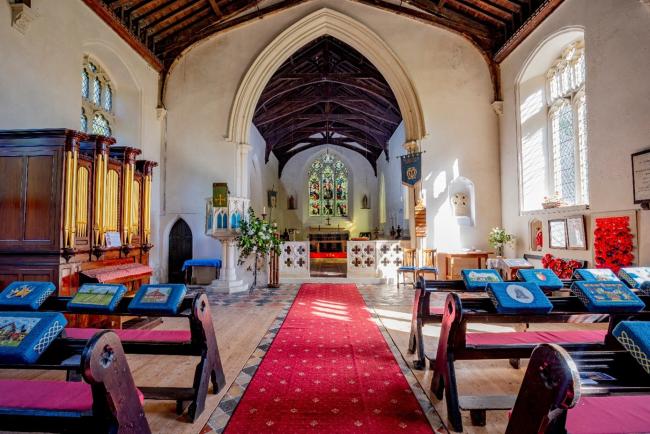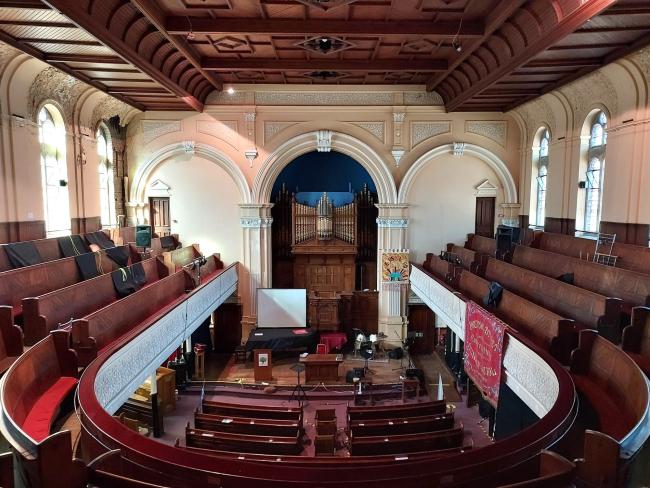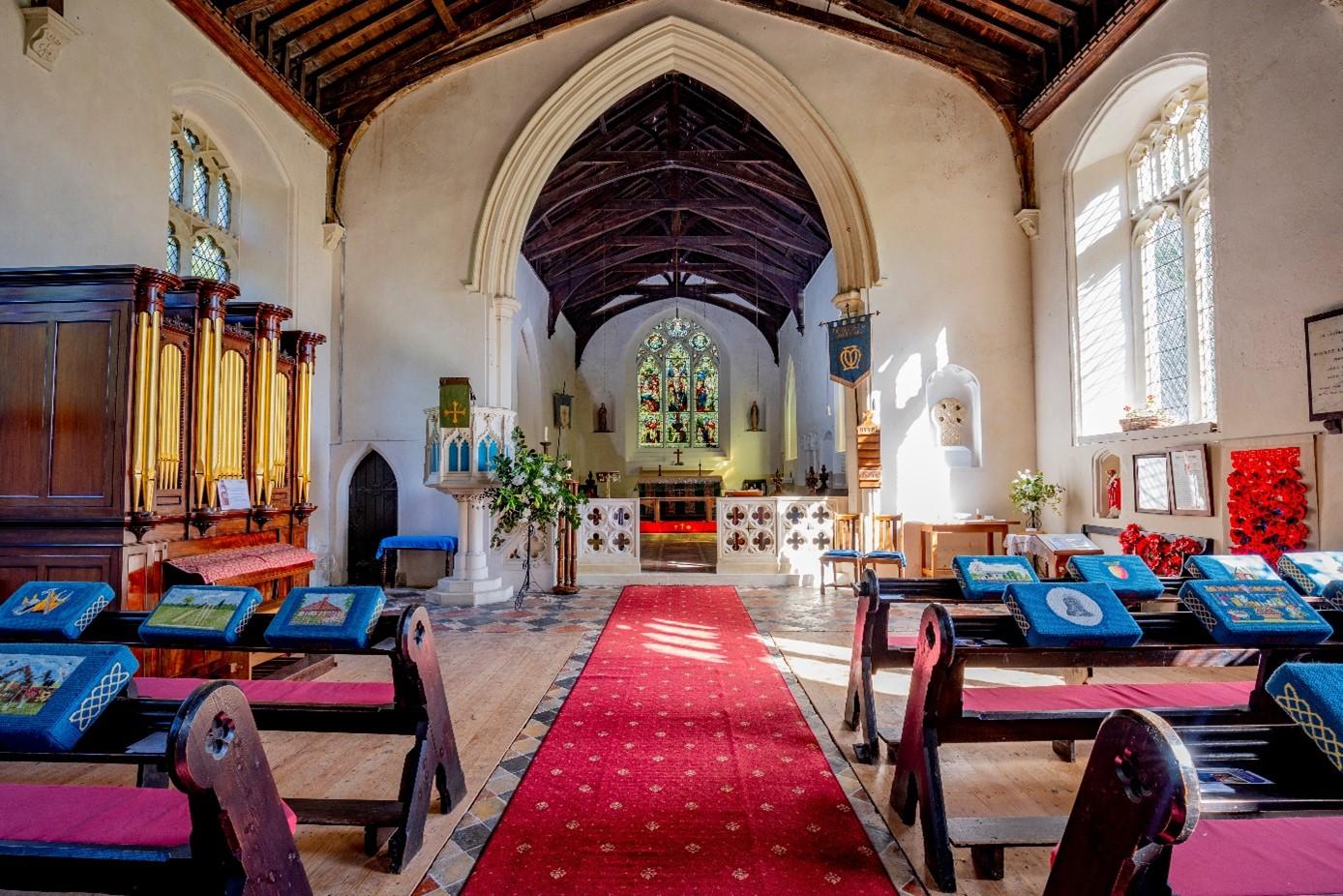The future of 49 churches, chapels and meeting houses is safe thanks to £421,000 of funding awarded by the National Churches Trust.
The latest funding from the National Churches Trust is a tremendous boost to 49 of the UK’s places of worship.
Coming just in time for Christmas, the grants awarded will help fund urgent repairs and installing modern community facilities. This will safeguard unique local heritage and keep churches open and in use for the benefit of local people. The National Churches Trust helps hundreds of historic churches each year and with the support of local people keeps them thriving today, and tomorrow.
Churches we are supporting include:
- A £30,000 National Churches Trust Cornerstone Grant will pay for urgent repairs to St Mark's church in Shelton, Stoke on Trent. Dubbed 'The Potter's Cathedral', the Grade II Listed church includes precious Victorian Minton tiles manufactured close by and three teracotta reliefs by renowned English ceramic artist George Tinworth.
- His Place Community church in the centre of Hastings receives a £27,000 National Churches Trust Cornerstone Grant to help fund urgently needed tower repairs. The Grade II Listed building, designed in 1885, features a superb horseshoe gallery which seats 700 people and retains many of its original features.
- Crawshawbooth Quaker Meeting House in Lancashire benefits from a £10,000 National Churches Trust Cornerstone Grant to help fund new accessible toilets and a kitchen to enable wider use by the local community and visitors. Built in the early 18th century, much of the interior of the Meeting House survives, providing insights into the way space was used for worship by Quakers in the past.
- St Mary's Church Room, in Cobham, Kent, a rare surviving example of a 'Tin Tabernacle' receives a £15,000 National Churches Trust Cornerstone Grant to upgrade the interior and provide new community facilities. This 'Tin Tabernacle' was produced in kit form by Norwich based Boulton & Paul in 1889 and served as the mission hall for St Mary Magdalene church in Cobham.
- Dating from the 1290s, Grade II* Listed St Peter and Paul in Wincanton, Somerset, has suffered from severe water damage in recent years. The church receives a £5,000 National Churches Trust Cornerstone Grant and also a £10,000 Wolfson Fabric Repair Grant from the Wolfson Foundation.
Thanks to our Friends and supporters
The grants are made possible thanks to our Friends and supporters including the Pilgrim Trust. Thanks to our partnership with the Wolfson Foundation, support of £137,000 for 15 churches is provided by Wolfson Fabric Repair Grants which support repair work at Listed churches in the UK.
Northern Ireland
Two churches in Northern Ireland, Ebrington Presbyterian Church on the Waterside of Derry/ Londonderry and Kilhorne Parish Church, Annalong, County Down, receive grants thanks to our Treasure Ireland project which is supported by the National Lottery Heritage Fund, the Pilgrim Trust and the Department for Communities.
Paul Ramsbottom, chief executive of the Wolfson Foundation said:
"As well as being places of worship and buildings of beauty, churches sit at the heart of the community. In many ways they stand between the past and present. We are thrilled to continue our partnership with the National Churches Trust to support the preservation of these significant, much-loved historic buildings across the UK.”
Full details
Three of the churches being helped are on the Historic England Heritage at Risk register.
Full details of Cornerstone Grants we have funded directly for fabric repairs and the installation of modern facilities can be found below, listed by alphabetical order of counties.
NCT Awards November 2022.pdf (120.35 KB)
CHESHIRE
Runcorn - St Berteline and St Christopher church - Unlisted
A £25,000 National Churches Trust Cornerstone Grant will help to pay for much needed community facilities with accessible toilets and larger kitchen ensuring the church thrives today and tomorrow.
The church
‘St Bert's’ as the church is affectionally known, is a simple breeze block and brick building opened in January 1981. The building has hardly been updated in the last 40 years. It has been in continuous use as a place of worship, only being closed to the public due to Covid restrictions. The church is located in the midst of social housing in an area of high deprivation with poor statistics for health and wellbeing.
The project
This is part of the first phase of a wider re-modelling project. It will make improvements to the church's existing community facilities enabling St Bert’s to be a community hub in this area of high deprivation. A £25,000 National Churches Trust Cornerstone Grant will facilitate accessible toilets and larger kitchen.
KENT
Cobham - St Mary's Church Rooms Unlisted
A £15,000 National Churches Trust Cornerstone Grant will help to pay for much needed community facilities for St Mary’s Church Room in Cobham. The money will help pay for a new accessible WC, kitchen and refurbished entrance, ensuring the church building can thrive today and tomorrow.
The church
The mission hall for St Mary Magdalene Church, Cobham, now called St Mary’s Church Room, was erected in 1889 both as a meeting room and church.
The building is a rare surviving example of a ‘Tin Tabernacle’. These were produced in kit form by Norwich based Boulton & Paul, a major producer of kits for corrugated iron buildings that arrived packaged ready for assembly. The timber framework was assembled on a base of rubble and mortar, bolted together and clad with corrugated iron sheets on garden land of the architect, Sir Herbert Baker, from his 15th century Wealden Hall House, ‘Yeomans’
In the 1940s, at a time of extreme austerity, an extension was added comprising a small porch on the south side and a lean-to service block on the west side housing a small kitchen and toilet, similarly timber framed and clad in corrugated metal. The chancel floor was raised, and a stage area added.
The project
In the 1940s, St. Mary’s Church Room was modernised to a low standard. A lean-to porch, toilet and kitchen was added and still features Bakelite light switches. A £15,000 National Churches Trust Cornerstone Grant will facilitate the replacement of an existing WC, new kitchen and refurbished entrance.

LANCASHIRE
Crawshawbooth - Quaker Meeting House - Grade II* Listed
A £10,000 National Churches Trust Cornerstone Grant will help to pay for much needed community facilities including the installation of accessible toilets and kitchen at Grade II* Listed Crawshawbooth Quaker Meeting House, ensuring it thrives today and tomorrow.
(c) Crawshawbooth Quaker Meeting House
The Meeting House
The Crawshawbooth Quaker Meeting House is an historic survivor of the early 18th century, which retains its essential historic form and character. It was built in a vernacular style typifying the modest nature of these buildings for worship. Underneath it is a stable in which the Friends who came to meetings stabled their horses.
In the later part of the 18th century newer, enlarged facilities were added. These include the planform and the Elders’ Stand, gallery, shuttered meeting room partition and fixed benches. These and other historic fabric preserved in the interior, provide evidence for the division of space and internal arrangements typical for earlier Quaker Meeting Houses.
The project
Crawshawbooth’s Quaker Meeting House is a Grade II* listed building and serves the whole of the Pendle Hill area Quaker community. A £10,000 National Churches Trust Cornerstone Grant will facilitate the installation of new accessible toilets and kitchen facilities in the building’s old stables and allow greater use of the building by a range of people.
LONDON
Union Chapel, Islington Grade II* Listed
A £25,000 National Churches Trust Cornerstone Grant will help to pay for urgent repairs to the roof and brickwork and add accessible toilets to Islington’s Union Chapel Sunday School Hall and help ensure it thrives today and tomorrow.
The building complex is on the Historic England Heritage at Risk Register and the repair work will safeguard this important building for the future.
The church complex
Union Chapel is a fantastic Victorian neo-gothic architectural gem in Islington London, built in 1877, with the upper part of the tower completed in 1888. The complex was designed by James Cubitt, a leading Victorian non-conformist architect and it is one of the most outstanding non-conformist church building complex in Great Britain.
The Grade II* Sunday School itself is a unique space, one of the few non-conformist halls still retaining the original Akron plan: a large, airy, double height room with a 3-sided wrap-around balcony complete with original study booths and library. It is a beautiful space that combines simple grandeur and practicality - it was intended to cater for a wide range of activities, including classes for up to 180 under-privileged children and families, teas and bazaars.
The project
Union Chapel Project will undertake an extensive refurbishment of Union Chapel’s Grade II* listed Sunday School Hall to enable a greater connection both to the heritage of Union Chapel’s nonconformist history, the current activities of the Church and other Union Chapel organisations, and embed the organisation as a driver for social change in Islington. The £25,000 National Churches Trust Cornerstone Grant will facilitate repairs to the roof and brickwork and enable the installation of accessible toilets.
NORFOLK
Hingham - St Andrew's church - Grade I Listed
A £25,000 National Churches Trust Cornerstone Grant will help to pay for much needed community facilities at the Grade I Listed church of St Andrew in Hingham with the installation of kitchen and toilet facilities, ensuring the church thrives today and tomorrow.
The church
St Andrew's church is an unusually large 14th century church constructed between 1320 and 1360. It has a nave and two side aisles which are all open plan. There is a six storey tower which is 120 feet high and anecdotally said to be the second highest in Norfolk.
The church is a fine example of the Decorated period. The windows have an exceptionally beautiful style of tracery, especially on the side walls of the chancel. There is significant architectural interest. Notable features include the Morley Tomb in the chancel, described by Pevsner as, 'one of the most impressive wall monuments of the 15th century in the whole of England'. There are 60 finely carved Victorian Arts and Crafts pews in the church. It has a double height hammer beam roof, which was restored in the 19th century.
The project
St Andrew’s is a Grade I listed building. The church has a vision to combine a fully functioning Christian Centre and Community Hub welcoming wide-reaching ecumenical and secular activities, promoting increased community engagement across a benefice which measures 200km2. A £25,000 National Churches Trust Cornerstone Grant will facilitate the installation of a new kitchen and toilet facilities.
Whissonsett - St Mary the Virgin Grade II* Listed
A £12,530 National Churches Trust Cornerstone Grant will help to pay for modern community facilities at the Grade II* Listed church of St Mary the Virgin in Whissonsett with the installation of a kitchen and fully accessible toilet in the church ensuring the church thrives today and tomorrow.
The church
St Mary the Virgin church was originally built about 1250 AD on the site of an earlier building, a short distance to the north of the present church. It stands in the centre of the village. Various restorations took place between 1870 and 1875 and between 1987 and 1994. A new floor was laid in 2004. Roof repairs were carried out in 2019-20.
The Nicolson organ - one of only two in the country - was built by Richard Nicholson in 1849-50 is in the nave. There is a memorial to Hugh and Derrick Seagrim, brothers who lost their lives in World War II. They were posthumously awarded the Victoria Cross and George Cross respectively - the only siblings to be so honoured.
The 14th century tower was crowned in the 15th century by a fine flushwork parapet containing shields and with four crocketted pinnacles at the corners. The east window glass shows the Nativity, the Crucifixion and the Resurrection in the main lights, with smaller scenes below of Jesus miracles. The glass was made by Ward & Hughes about 1865.
The project
St Mary the Virgin is a Grade II* listed building. Village growth means the new facilities will enable St Mary’s to better serve its community.

SOMERSET
Wincanton - St Peter and St Paul's church Grade II* Listed
A £5,276 National Churches Trust Cornerstone Grant will help to pay for urgent repairs to the roof of Grade II* Listed St Peter and St Paul’s church in Wincanton, ensuring the church thrives today and tomorrow. The church also receives a £10,000 Wolfson Fabric Repair Grant from the Wolfson Foundation on the recommendation of the National Churches Trust.
The church
St Peter and St Paul’s is believed to date from the 1290s although the oldest surviving fabric is found in the lower part of the tower and dates from the 14th century. The church was enlarged and largely rebuilt by Nathaniel Ireson (a well-known local architect) in 1735 and enlarged/rebuilt again in 1887-9 by J D Sedding, who built a new nave to the north of the previous nave.
There is a war memorial window to commemorate those who lost their lives in the two world wars and the church hosted a homecoming parade for troops returning from Afghanistan.
The project
St Peter and St Paul’s is a Grade II* listed building. Set in the centre of the small town, the church has suffered from water damage and two roofs have been identified as needing to be replaced. A £5,276 National Churches Trust Cornerstone Grant and a £10,000 Wolfson Fabric Repair Grant will help to fund these repairs to the damaged roofs
STAFFORDSHIRE
Shelton, Stoke on Trent - St Mark's church - Grade II Listed
A £30,000 National Churches Trust Cornerstone Grant will help to pay for urgent repairs to the tower stonework, nave roof and ceiling plaster of Grade II Listed St Mark’s church in Shelton, ensuring the church thrives today and tomorrow.
St Mark’s is currently on the Historic England ‘Heritage at Risk’ register and the repair work will safeguard this important building for the future.
The church
St Mark’s is one of a series of important ‘Commissioners Churches’ built in the expanding pottery towns in the early 19th century. The building is distinguished by its beautiful interior, which retains the original galleries with unusual cast ironwork.
St Mark’s most exceptional feature is the group of three large and beautifully modelled terracotta reliefs by George Tinworth, the renowned English ceramic artist who worked for the Doulton’s factory in Lambeth from 1867 until his death. George Tinworth is responsible for notable works of architectural significance throughout Europe.
Stoke-on-Trent was one of the most significant global powerhouses of ceramic production and St Mark’s reflects this. It includes a considerable number of Victorian Minton (Minton and Hollins) tiles. Those tiles would have been manufactured within a mile of the church and the parishioners of the time would have almost certainly included the people who produced them.
The project
St Mark’s is a Grade II listed building. Hoarding and fencing has had to be erected at the base of the church’s tower to protect the public from falling masonry. The funding will facilitate repairs to the tower stonework, nave roof and ceiling plaster.
SUSSEX
Hastings - His Place Community church Grade II Listed
A £27,200 National Churches Trust Cornerstone Grant will help to pay for urgent repairs to the tower of Grade II Listed His Place Community church, ensuring it can thrive today and tomorrow.
The church is on the Historic England Heritage at Risk Register.

The church
His Place Community Church is a free church, unaffiliated with any major denomination.
The building, bought from the United Reform Church in 2013, was designed in 1885 by the prolific Hastings architect Henry Ward. Ward's Grade II-listed building is a landmark presence in the Trinity Triangle area of central Hastings, with two striking Classical facades visible to the public: a tall, narrow one facing Robertson Street to the east and a large, six-bay elevation facing Cambridge Road to the north.
The Congregational Church was a significant social and political force in Victorian Hastings. Its members spared little expense in building their new church, which replaced an earlier one built on the same site in 1855 and which they had outgrown. The fundraising for the new church was driven by Halley Stewart (1838-1937). He was an industrialist who was later to win national renown as a Liberal politician and philanthropist; in the 1880s he was a lay preacher in Hastings with a fiery commitment to social justice.
Victorian state-of-the-art technology was used in the new church's construction, including a steel-supported flying gallery to increase the size of the worship space on what is a very constricted urban site; electric lighting (a first in the UK for a nonconformist church), and patented ventilators for air circulation.
Today the interior retains many of its original features, such as the linoleum floor, elegantly curved pews and heating pipes, and elaborate plaster decoration by George Jackson & Sons.
The large horse-shoe galleried worship space, which seats 700 people, remains a strikingly beautiful venue with a superb acoustic for unamplified music.
The project
His Place Community Church is a Grade II listed building. The building was in a poor state of repair when it was purchased it in 2013. The urgency for major repairs has now reached a critical level. A £27,200 National Churches Trust Cornerstone Grant will facilitate repairs to the tower. This will include work on the masonry, stonework, window and gutter repairs and extensive repointing.

